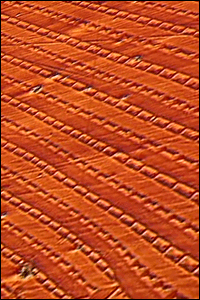Press Release
Swelling Magnets to Energize the World
Discovery Sheds New Light on 175-year-old Principle
FOR IMMEDIATE RELEASE May 21, 2015
CONTACT:
Faye Levine
301 405 0379
flevine@umd.edu

Never-before-seen highly periodic magnetic ‘cells’ or ‘domains’ in iron-gallium alloys responsible for non-Joulian magnetism. Image courtesy of Harsh Chopra.
A new class of magnets that expand their volume when placed in a magnetic field and generate negligible amounts of wasteful heat during energy harvesting, has been discovered by researchers at the University of Maryland (UMD) and Temple University.
The researchers, Manfred Wuttig, a professor of materials science and engineering and affiliate of the Maryland NanoCenter at UMD and his former Ph.D. student, Harsh Deep Chopra (Ph.D. ’93), now professor and chair of mechanical engineering at Temple, published their findings, “Non-Joulian Magnetostriction,” in the May 21st issue of the journal Nature. (DOI:10.1038/nature14459).
“Our findings fundamentally change the way we think about a certain type of magnetism that has been in place since 1841,” said Chopra, who also runs the Materials Genomics and Quantum Devices Laboratories at Temple’s College of Engineering and participates in Temple Materials Institute.
In the 1840s, renowned physicist James Prescott Joule (the unit of energy is named in honor of him) discovered that iron-based magnetic materials changed their shape but not their volume when placed in a magnetic field. This phenomenon is referred to as “Joule Magnetostriction,” and since its discovery 175 years ago, all magnets have been characterized on this basis.
“We have discovered a new class of magnets, which we call ‘Non-Joulian Magnets’ that show a large volume change in magnetic fields. Moreover, these non-Joulian magnets also possess the remarkable ability to harvest or convert energy with minimal heat losses,” said Chopra.
“The response of these magnets differs fundamentally from that likely envisioned by Joule. He must have thought that magnets respond in a uniform fashion.” Wuttig said. Instead, the researchers found a never before seen microscopic cellular-like structure whose response to a magnetic field is at the heart of non-Joulian magnetostriction. “Knowing about this unique structure will enable the researchers to develop new materials with similarly attractive properties.” Wuttig added.
This transformative breakthrough has the potential to not only displace existing technologies but create altogether new applications due to the unusual combination of magnetic properties. The impact of this discovery may be best summarized by Herbert Kromer’s criterion for Transformative Technologies [Nobel Lecture, 2000]: “The principal applications of any sufficiently new and innovative technology always have been — and will continue to be — applications created by that technology.”
For instance, conventional magnets can only be used as actuators for exerting forces or causing displacements in one direction since they are limited by Joule magnetostriction. Actuation, even in two directions, requires bulky stacks or composites, which increase the size and reduce efficiency. Adding actuation in a third direction is even more cumbersome. Since non-Joulian magnets spontaneously expand in all directions, compact omnidirectional actuators can now be easily realized. Add to this their energy efficient characteristics one can begin to create a new generation of sensors and actuators with vanishingly small heat signature. Recalling that 99% of all energy conversion requires magnetism of one form or another, example where these magnets would find applications include efficient energy harvesting devices, compact micro-actuators for aerospace, automobile, biomedical, space and robotics applications, ultra-low thermal signature actuators for sonars and defense applications, etc. Since these magnets are free of rare-earth elements, they would replace existing rare-earth based magnetostriction alloys, which are expensive and feature inferior mechanical properties.
In boosting energy harvest from renewable sources like solar or wind, and make them competitive relative to fossil fuels, one cannot afford to lose too many Joules of energy. These ‘distributed’ forms of energy sources get a boost from non-Joulian magnets because it is now possible to harvest intermittent or even small quantities of energy efficiently. For instance, a small device, such as a hand-energized LED flashlight, would stay lit for a long time.
“Chopra and Wuttig’s work is a good example of how basic research advances can be true game changers,” said Tomasz Durakiewicz, National Science Foundation condensed matter physics program director. “Their probing of generally accepted tenets about magnetism has led to a new understanding of an old paradigm. This research has the potential to catapult sustainable, energy-efficient materials in a very wide range of applications.”
The research was supported by the Metals and the Condensed Matter Physics programs of the National Science Foundation’s Division of Materials Research.
Copies of this study are available to working journalists and may be obtained by contacting Preston M. Moretz in Temple’s Office of Strategic Marketing and Communications at pmoretz@temple.edu.
About the A. James Clark School of Engineering
The University of Maryland’s A. James Clark School of Engineering is a premier program, ranked among the top 20 in the world. Located just a few miles from Washington, D.C., the Clark School is at the center of a constellation of high-tech companies and federal laboratories, offering students and faculty access to unique professional opportunities.
Our broad spectrum of academic programs, including the world’s only accredited undergraduate fire protection engineering program, is complemented by a vibrant entrepreneurial ecosystem, early hands-on educational experiences, and participation in national and international competitions.
The Clark School is leading research advancements in aerospace, bioengineering, robotics, nanotechnology, disaster resilience, energy and sustainability, and cybersecurity. From the universal product code to satellite radio, SMS text messaging to the implantable insulin pump, our students, faculty, and alumni are engineering life-changing innovations for millions. Learn more at www.eng.umd.edu.